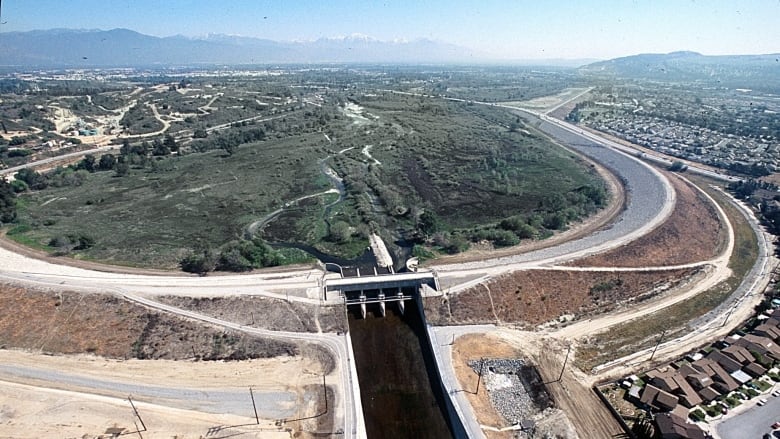California dam at risk of 'catastrophic failure' in mega-storm, climate scientist says
Daniel Swain says if Whittier Narrows Dam fails, flooding would be more devastating than a major earthquake

Engineers say a Los Angeles dam could fail in the event of a mega-storm and trigger catastrophic flooding — and that's not the only problem.
The U.S. Army Corps of Engineers, which oversees the 62-year-old Whittier Narrows Dam, says the structure no longer meets its guidelines and could fail in the event of a powerful storm called "The Other Big One", causing rapid flooding in populated areas, unless officials heed their advice and invest hundreds of millions of dollars into repairing it.
Daniel Swain, a climate scientist at UCLA and the National Center for Atmospheric Research, says the dam isn't the only infrastructure at risk.
Swain spoke to As It Happens host Carol Off about why upgrades to infrastructure across the U.S. are necessary to combat the effects of climate change.
Here is part of their conversation.
Mr. Swain, what would a mega-storm, known as "The Other Big One," look like?
Well, one of the reasons why a storm, or really a series of storms, is called "The Other Big One," is because the original "Big One" is a large magnitude earthquake on the San Andreas Fault, near Los Angeles or San Francisco, which itself would obviously be a devastating natural disaster.
But in a contingency planning exercise that the State of California completed just a few years ago, they actually found that a flood of this extreme magnitude could actually be more economically destructive than one of these large earthquakes.

And how devastating would it be?
Well, the last time a flood of this magnitude occurred in California was 1862, which obviously is before most of the people who now live there, most of the cities that now exist in California, [and] most of the industry that now exists was in place.
Back then, California had a population of about 400,000. Today, it's closer to 40 million.
Millions of people live today in what naturally are flood plains. And historically they've been protected to large degree by a fairly intricate system of dams and levees and other flood protection infrastructure that has kept water, for the most part, out of the major urban areas.
But a storm series of this magnitude would likely overwhelm most of those systems. And recent research has suggested [it] could even threaten the structural integrity of really important infrastructure like major dams.
Recent research (& real-world experience) suggest changing climate & decaying infrastructure on collision course. “Many pieces of water infrastructure...may not be up to the challenge of brave new 21st century <a href="https://twitter.com/hashtag/climate?src=hash&ref_src=twsrc%5Etfw">#climate</a>.” by <a href="https://twitter.com/LouisSahagun?ref_src=twsrc%5Etfw">@LouisSahagun</a> <a href="https://twitter.com/hashtag/CAwx?src=hash&ref_src=twsrc%5Etfw">#CAwx</a> <a href="https://twitter.com/hashtag/CAwater?src=hash&ref_src=twsrc%5Etfw">#CAwater</a> <a href="https://t.co/AAyEb6rPOX">https://t.co/AAyEb6rPOX</a>
—@Weather_WestAnd in particular the Whittier Narrows Dam — that's the one that's been under study, right?
The Army Corps of Engineers recently announced that that particular dam was potentially at risk of catastrophic failure during a large enough precipitation event and subsequent flood event.
And so the big concern there is that not only do you have flooding, but you could potentially have an actual failure of that dam. And apparently that dam is considered to be one of the highest risk structures in the country.
But it's also important to realize that it probably isn't the only structure that is potentially at risk in a sufficiently extreme flood event.
A recent study that came out just last week, not conducted by the Army Corps of Engineers, but by independent researchers at the University of California suggested that climate change actually would increase the risk of structural failure at major dams in California as the frequency and intensity of precipitation events increases.

You mentioned there's like 40 million people now living in that region — what would happen to them?
Although we don't like to talk about it, the consequences of a dam failing in a populated area are really high because obviously you don't just have a slow gradual flood. You have a rapid inundation from a wall of water and the Army Corps study that just came out had painted a pretty dire picture of what some of the urban areas downstream of this dam would look like.
If it collapses completely, which is very rare, but if it happens, the water rises very fast and it can be a real threat — not just to property — but also to life and limb.
Are you curious about the state of our dams in the U.S.? The U.S. Army Corps of Engineers National Inventory of Dams website has a wealth of information and we’re now updating the NID annually instead of every two years. <a href="https://twitter.com/hashtag/water?src=hash&ref_src=twsrc%5Etfw">#water</a> <a href="https://twitter.com/hashtag/infrastructure?src=hash&ref_src=twsrc%5Etfw">#infrastructure</a> <a href="https://t.co/1aqlSzDIaH">https://t.co/1aqlSzDIaH</a> <a href="https://t.co/o8ixzBPNkn">pic.twitter.com/o8ixzBPNkn</a>
—@USACEHQWhat we're watching from Washington is that the priority coming out of the White House is to get billions of dollars to build a wall between the United States and Mexico. Do you think it's difficult to switch those priorities — if that's considered be the national emergency?
Let me put it this way, the risk assessment that the State of California put out a few years ago — looking at the potential for a really extreme flood event to unleash a really catastrophic economic and humanitarian disaster — it suggested that the economic cost of such an event in modern day California could approach a trillion dollars.
So the cost of not addressing the problem rises pretty quickly the longer that we wait to address it. And so I think, just from a cost-benefit perspective, I think that there's some pretty powerful motivations to approach this pretty aggressively.
Written by Sarah Jackson and John McGill. Interview produced by Sarah Jackson. Q&A has been edited by length and clarity.